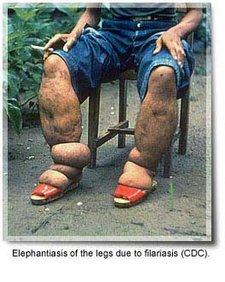Elephantiasis
Elephantiasis is a parasitic disease which is transmitted from human to human by mosquito bites. The parasite tends to lodge in and block the lymph nodes that drain into the lower extremities, producing massive enlargement and deformity of the legs and genitalia. Dramatic photographs of those affected appear in every infectious disease text. more...
Organisms that cause the disease are Wuchereria bancrofti, Brugia malayi, and B. timori, all transmitted by mosquitoes. Lymphatic filariasis currently affects 120 million people worldwide, and 40 million of these people have been seriously infected with the disease, which is extremely rare in the Western countries, and is found almost exclusively in the tropics. The disease is also called bancrofitan filariasis and lymphatic filariasis. Brugia malayi causes a similar disease, while Onchocerca volvulus causes many disorders in addition to elephantiasis.
Elephantiasis should not be confused with Proteus syndrome, a completely different disorder partly responsible for the deformity of the "Elephant Man" Joseph Merrick.
Treatment
Medicines to treat lymphatic filariasis are most effective when used soon after infection, but they do have some toxic side effects. In addition, the disease is difficult to detect early. Therefore, improved treatments and laboratory tests are needed. A vaccine is not yet available.
Antibiotics as a possible Treatment
In June 2005, a new study from the Liverpool School of Tropical Medicine reported that common antibiotics such as doxycycline may be effective in treating elephantiasis. The parasites responsible for elephantiasis have a population of symbiotic bacteria, wolbachia, that live inside the worm. When the symbiotic bacteria are killed by the antibiotic, the worms themselves also die.
Read more at Wikipedia.org



